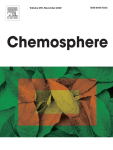View Item
- xmlui.general.dspace_homeCentros Regionales y EEAsCentro Regional Mendoza - San JuanEEA San JuanArtículos científicosxmlui.ArtifactBrowser.ItemViewer.trail
- DSpace Home
- Centros Regionales y EEAs
- Centro Regional Mendoza - San Juan
- EEA San Juan
- Artículos científicos
- View Item
Phytoextraction of Cu, Cd, Zn and As in four shrubs and trees growing on soil contaminated with mining waste
Abstract
Mining activity has degraded large extensions of soil and its waste is composed of metals, anthropogenic chemicals, and sterile rocks. The use of native species in the recovery of polluted soils improves the conditions for the emergence of other species, tending to a process of ecosystem restoration. The objective of this study was to evaluate the bioaccumulation of metal(loid)s in four species of native plants and the effect of their distribution and
[ver mas...]
Mining activity has degraded large extensions of soil and its waste is composed of metals, anthropogenic chemicals, and sterile rocks. The use of native species in the recovery of polluted soils improves the conditions for the emergence of other species, tending to a process of ecosystem restoration. The objective of this study was to evaluate the bioaccumulation of metal(loid)s in four species of native plants and the effect of their distribution and bioavailability in soil with waste from an abandoned gold mine. Soil samples were taken from two sites in La Planta, San Juan, Argentina: Site 1 and Site 2 (mining waste and reference soil, respectively). In Site 1, vegetative organ samples were taken from Larrea cuneifolia, Bulnesia retama, Plectrocarpa tetracantha, and Prosopis flexuosa. The concentration of metal(loid)s in soil from Site 1 were Zn > As > Cu > Cd, reaching values of 7123, 6516, 240 and 76 mg kg−1, respectively. The contamination indices were among the highest categories of contamination for all four metal(loid)s. The spatial interpolation analysis showed the effect of the vegetation as the lowest concentration of metal(loid)s were found in rhizospheric soil. The maximum concentrations of As, Cu, Cd and Zn found in vegetative organs were 371, 461, 28, and 1331 mg kg−1, respectively. L. cuneifolia and B. retama presented high concentrations of Cu and Zn. The most concentrated metal(loid)s in P. tetracantha and P. flexuosa were Zn, As and Cu. Cd was the least concentrated metal in all four species. The values of BAF and TF were greater than one for all four species. In conclusion, the different phytoextraction capacities and the adaptations to arid environments of these four species are an advantage for future phytoremediation strategies. Their application contributes to the ecological restoration and risk reduction, allowing the recovery of ecosystem services.
[Cerrar]

Author
Heredia, Tatiana Belén;
Tapia Balmaceda, Raúl Esteban;
Young, Brian Jonathan;
Hasuoka, Paul;
Pacheco, Pablo;
Roqueiro, Gonzalo;
Fuente
Chemosphere 308 (2) : 136146 (December 2022)
Date
2022-12
Editorial
Elsevier
ISSN
1879-1298
0045-6535
0045-6535
Documentos Relacionados
Formato
pdf
Tipo de documento
artículo
Proyectos
(ver más)
INTA/2019-PD-E2-I039-002/2019-PD-E2-I039-002/AR./REMEDIACIÓN DE SUELOS Y AGUAS Y RESTAURACIÓN ECOLÓGICA DE SISTEMAS DEGRADADOS POR USO AGROPECUARIO, AGROINDUSTRIAL Y ACTIVIDADES EXTRACTIVAS
Palabras Claves
Derechos de acceso
Abierto
 Excepto donde se diga explicitamente, este item se publica bajo la siguiente descripción: Creative Commons Attribution-NonCommercial-ShareAlike 2.5 Unported (CC BY-NC-SA 2.5)
Excepto donde se diga explicitamente, este item se publica bajo la siguiente descripción: Creative Commons Attribution-NonCommercial-ShareAlike 2.5 Unported (CC BY-NC-SA 2.5)

